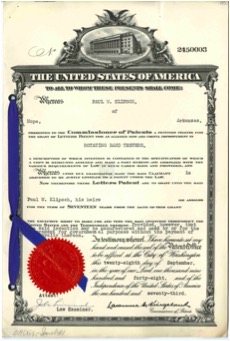Southwestern Proving Ground (SPG)
/In 1941 PWK was at the height of his 3rd career, oil prospecting. He worked in Houston, TX for Dr. E. E. Rosaire, initially at Independent Exploration, and then he followed Rosaire to Subterrex. It was his first job after receiving his graduate degree of Engineer at Stanford. Rosaire had a saying that PWK never forgot: “When any of you guys piss with your left hand, I want to get a patent on it!” In the seven years with Rosaire he received eight patents in electrical and acoustic methods of discovering oil.
(Operational 1942-1945)
World War II was raging in Europe, but the U.S. had not become directly involved. In a preemptive move, the government decided to build a munitions proving ground in Hope, AR. In large measure it was intended to be a “duplicate” of the Jefferson Proving Ground in Indiana.Paul had been in the ROTC in high school and college. As he often said, “Uncle Sam punched my ticket!” Following a couple of weeks training at Aberdeen Proving Ground, Paul was on his way to Hope, AR to supervise construction, and ultimately become chief engineer. This put him second in command of several thousand troops. And while putting in 70-90 hours a week for Uncle, he used his “spare time” to finish the design of his speaker that had its roots in Houston. The Klipsch Archives has an extensive collection of correspondence between the “chronograph boys” at the three major munitions proving grounds, Southwestern (PWK), Aberdeen (F.W. Whitlock), and Jefferson (J.A. Tolan).
Recently I was given access to an engineering report concerning the closing of SPG. The magnitude of the facility has been largely forgotten. The report was prepared by the engineering firm of Reese and Nichols for Reconstruction Finance Corporation (RFC) and dated January 18, 1946. The intent was to prepare the Disposal Agency (RFC) to assume control from the Custodial Agency (the Ordnance Department, U.S. Army). The War Department had declared the facility “surplus” on September 24, 1945. It definitely didn’t take them long, as the Japanese surrender was on September 2, 1945.
What follows is a list of impressive facts about SPG:
1. 50,098.62 acres in total
2. Of that, 28,000 acres of “contaminated debris fields” described in 1946 as “wasteland”
3. 3200 acres cleared with hand axes
4. Over 3,000,000 rounds tested
5. 20MM – 155MM ammunition for “guns, howitzers, and mortars”
6. Some testing of bombs up to 2000#, as well as “pyrotechnics”
7. Eventually Army and Navy rockets
8. All ammunition was held in temperature-controlled facilities to improve test uniformity
9. Much of the ammunition was assembled on site
10. Range distance varied from 500 yards to 16,000 yards (over nine miles)
11. All 18 recovery fields were provided with observation bunkers
12. The airport was the 3rd largest in the country
13. Three 5500’ runways, 150’ wide
14. 1,260,000 cubic yards of earth were moved in its construction
15. The Air Force Detachment of the Army (no Air Force as yet) was separately housed in barracks at the airport
16. At the height of operations there were 45 officers
17. Design operations began in July 1941
18. Between July 7, 1941 and December 9, 1942 some 600 designs were prepared
19. A maximum of 268 personnel were involved in design
20. W. E. Callahan Construction Company of Dallas was the primary contractor, beginning on July 25, 1941
21. Initial offices were located in the Hope, AR High School building, then being moved to temporary quarters at SPG on August 29, 1941
22. Peak construction personnel numbered 12,381
23. 581 separate tracts of land were appropriated
24. Land values were from $5.00/acre to $70.00/acre
25. Four schools were displaced
26. Ten churches were displaced
27. Six cemeteries with 1060 graves were moved
28. 242 buildings and structures were constructed
29. The Telephone Exchange Building (KHMA’s!) is the only building with a basement
30. Water was supplied from two 1150’ deep wells designed for 1,000,000 gallons/day
31. Two sewerage systems, one with a treatment plant
32. 96.5 miles of roads
33. 2000 KW capacity three-phase electrical system with 440 line poles
34. 12.4 miles of railroad lines
35. 253,682 linear feet of fencing, 8’ high, with 6 strands of barbed wire at the top
36. 99 miles of administration telephone lines
37. 41 miles of field telephone lines
38. 20,000 linear feet of chronograph lines (PWK’s area of expertise)
39. The chronograph equipment worth $70,000 was transferred to Aberdeen Proving Ground ($900,000 in 2018)
Kind of a big deal!
When asked about his service, Paul usually replied: “I fit the battle of Arkansas!” During his service he patented the method of quality testing of the 105mm Howitzer round (U.S. PATENT #2,450,003 titled “Rotating Band Testers”). At the beginning of the War the duds were falling on our own troops.
He also worked on another never-issued patent concerning bomb burst concussion measurement. The method “by the Army book” at that time was developed in the 19th century, and literally consisted of a board with different size holes. One placed a sheet of paper on the board and observed what size holes the paper ruptured into. The smaller the hole, the bigger the concussive force.
Paul’s concept was a super heavy duty microphone with replaceable diaphragms. This would have provided an actual graph of the concussive force with respect to time. I guess they were so glad to be wrapping up the War that they were not paying attention.
Copyright 2018 Jim Hunter and KHMA, Inc.





